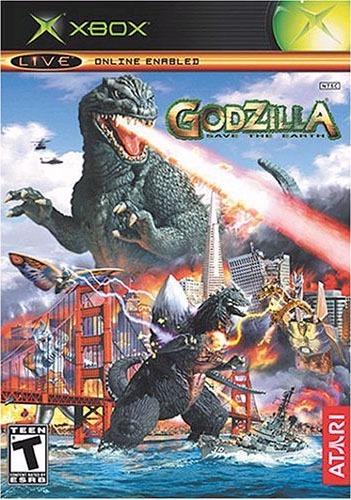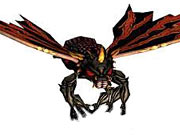Godzilla: Save the Earth
| Atari/Pipeworks Godzilla Games | |||||||
|
|
| |||||
| |||||||||||||||||||||||||||||||||||||||||||||||
Godzilla: Save the Earth (ゴジラ 怪獣大乱闘 地球最終決戦 Gojira Kaijū Dairantō: Chikyū Saishū Kessen, lit. Godzilla Monster Melee: Earth Final Battle) is a fighting game for the PlayStation 2 and Xbox. developed by Pipeworks and published by Atari, serving as a sequel to Godzilla: Destroy All Monsters Melee. The PlayStation 2 version was released in North America on November 2, 2004, in the PAL region on November 9, 2004[1], and in Japan on December 10, 2004. The Xbox version was released in North America on November 16, 2004 and in the PAL region on November 19, 2004.[2]
The game was followed by Godzilla: Unleashed in 2007.
Story
After failing to invade the Earth in 2002, the Vortaak return to Earth two years later with all of the monsters under their control, with their ultimate weapon, SpaceGodzilla. The player assumes the role of a monster who has broken free of the control, regardless of what monster is picked. If the player completes the game on hard mode with Godzilla 2000, a cutscene will be shown where Godzilla creates a black hole by blowing off SpaceGodzilla's shoulder crystals, which sucks him in, thus saving the world.
The original story during development was much more elaborate, involving the Vortaak infiltrating human society to steal G-cells.
Monsters
Playable
- Anguirus (Showa)
- Baragon
- Destoroyah (Perfect Form)
- Gigan (Showa)
- Godzilla 90's
- Godzilla 2000
- King Ghidorah
- Kiryu (Referred to as "Mechagodzilla 3" in-game)
- Mecha-King Ghidorah
- Jet Jaguar
- Mechagodzilla (Heisei) (Referred to as Mechagodzilla 2 in-game)
- Megaguirus
- Megalon
- M.O.G.U.E.R.A. (Referred to as "M.O.G.U.E.R.A. 2" in-game)
- Mothra (Larva and Imago)
- Orga
- Rodan (Heisei)
- SpaceGodzilla (Combat Form)
Destoroyah (Perfect Form)
Kiryu ("Mechagodzilla 3")
Mothra Imago
Mothra Larva
SpaceGodzilla (Combat Form)
Unplayable
- Battra (Airstrike)
- Ebirah (Showa) (Boss in the Challenges Mode rail shooter level "Undersea Battle")
- Meganula (Megaguirus' rage attack)
- Millennian (Boss in the Challenges Mode level "Mothership")
- SpaceGodzilla (Flying Form) (Boss in the Challenges Mode rail shooter level "Asteroid Field")
SpaceGodzilla (Flying Form)
Scrapped/Unused
- Battra was to be made playable after the Super X3 was added, but ultimately ended up as an air strike like the latter. Battra became playable in the PS2 version of Godzilla: Unleashed.
- Biollante (Plant Beast Form) was behind, and as a result Atari wasn't able to get the license in time; despite being eventually completed and still being present in the game's code. Biollante is the only monster in any of the Atari/Pipeworks Godzilla games to be fully completed but scrapped from the finished game. In 2014, hackers utilizing the PlayStation 2 emulator PCSX2 managed to access Biollante's data and render her playable. She was later included as a playable character in the Wii version of Godzilla: Unleashed.
- Godzilla 1954 was set to be a secret character but did not make the cut due to the presence of two Godzillas already. He was later included as a playable character in the Wii version of Godzilla: Unleashed.
- Hedorah was strongly considered but was not included due to the limitations of the consoles.
- Rainbow Mothra is depicted on the box art, but this is likely just an art error. During an interview for Godzilla: Unleashed Simon Strange mentioned that Rebirth of Mothra characters would not be allowed due to Toho considering it a separate series.
- Showa Mechagodzilla was set to be a secret character but did not make the cut due to the presence of two Mechagodzillas already. Like many of the other unused fighters from Save the Earth, it was later included as a playable character in the Wii version of Godzilla: Unleashed.
- Super Mechagodzilla was considered according to Simon Strange.
- Titanosaurus was included in some concept art for the game and, at least according to Simon Strange, was considered to be a fighter, as he cited the monster as the primary inspiration for Megaguirus' energy-stealing ability seen in the final game. He was later included as a playable character in the Wii version of Godzilla: Unleashed.
- Varan was not directly considered but according to Simon Strange would have been "their next choice". He later became playable in the Wii version of Godzilla: Unleashed.
Vehicles
- Battleships
- Helicopters
- Submarines
- Super X3 (airstrike)
- Tanks
Arenas
In-Game
Most of these have options for switching between day and night settings.
- Asteroid Field (Challenges Mode "Asteroid Field" M.O.G.U.E.R.A. rail shooter only)
- Boston (with Fenway Park)
- Boston
- Boston East
- Boxing Ring (Nearly identical to the arena from the Xbox version of Godzilla: Destroy All Monsters Melee, only with the Godzilla: Save the Earth logo)
- Los Angeles
- L.A. South
- Los Angeles
- Mothership (Does not have day or night settings)
- Ocean (Challenges Mode "Undersea Battle" Godzilla 2000 rail shooter only)
- Seattle
- Seattle
- Seattle North
- London
- London
- London East
- Monster Island
- Monster Island
- Monster Island Bay
- New York
- Manhattan
- New York
- Osaka
- Osaka
- Osaka North
- San Francisco (with AT&T Park)
- Golden Gate
- San Francisco
- Tokyo
- Tokyo
- Tokyo Bay
Scrapped
- An Ice Level set in Antarctica is shown in two pieces of concept art, one of Titanosaurus and other monsters battling it out. The second includes a description of gameplay in the level. It is a picture of Godzilla 2000 falling into an ice flow with Kiryu watching. It reads "Monsters can fall through ice flow hazards. They will re-emerge in the ocean section of the arena."
- Las Vegas is seen in concept art for the game. Toho Kingdom has this screenshot and it is unknown if it is the only concept art of Vegas. The art shows Godzilla 1990's holding the Hard Rock Hotel's guitar, prepared to use it against Mecha-King Ghidorah.
- Rodan Challenges Mode Rail Shooter was a rail shooter seen only in concept art. It was to function similarly to the Godzilla 2000 and M.O.G.U.E.R.A. ones, only this one set in a desert.
- Statue Level was a level briefly described in an interview and seen in concept art that would have involved fighting Destoroyah while trying to activate a statue of Jet Jaguar.
Miscellaneous Scrapped Elements
Many of the game's elements were scrapped, due to a combination of time constraints and licensing issues. This was possibly due to Atari rushing the game in order to coincide with the release of Godzilla: Final Wars in 2004. Biollante was scrapped prior to release despite being fully completed and the whole story, shown above, was cut, even though most of the time spent on the game was on the story mode. Simon Strange was a man who worked on the game, and he stated that it wasn't the "feel good" project that Godzilla: Destroy All Monsters Melee was. Las Vegas, a city, was cut, the Rodan rail shooter was cut; the list goes on. There was originally going to be a robust tokens system, but it was eventually cut. Most of the cut-scenes were deleted along with the story, and the special effects for Anguirus' roar were changed.[citation needed]
Challenges Mode Missions
- Asteroid Field
- Battleships
- Clone Attack
- Demolition
- Monster Bowling
- Monster Roundup
- Mothership
- Osaka Crunch
- Replicator
- UFO Attack
- Undersea Battle
- Vorillium Basketball
Gallery
Videos
- Main article: Godzilla: Save the Earth/Videos.
Trivia
- The Japanese box art features the 2001 versions of King Ghidorah and Mothra.
- Anguirus' roar originally had some sort of "shockwave" effect when it was used at full charge. The waves were not correctly drawn at all angles, so they were cut.
- This game is playable on Xbox 360.
- M.O.G.U.E.R.A. is referred to as "MOGUERA 2" in this game.
External Links
- Game manual for the North American Xbox version
- Game manual for the Japanese PlayStation 2 version
- Toho Kingdom archived news log of reports over the course of the game's development
- Toho Kingdom archived E3 videos
- Toho Kingdom interview between Chris Mirjahangir and Simon Strange
- WayBack Machine archive of the opening page for Godzilla.com "The Official Godzilla Website"
References
This is a list of references for Godzilla: Save the Earth. These citations are used to identify the reliable sources on which this article is based. These references appear inside articles in the form of superscript numbers, which look like this: [1]
































